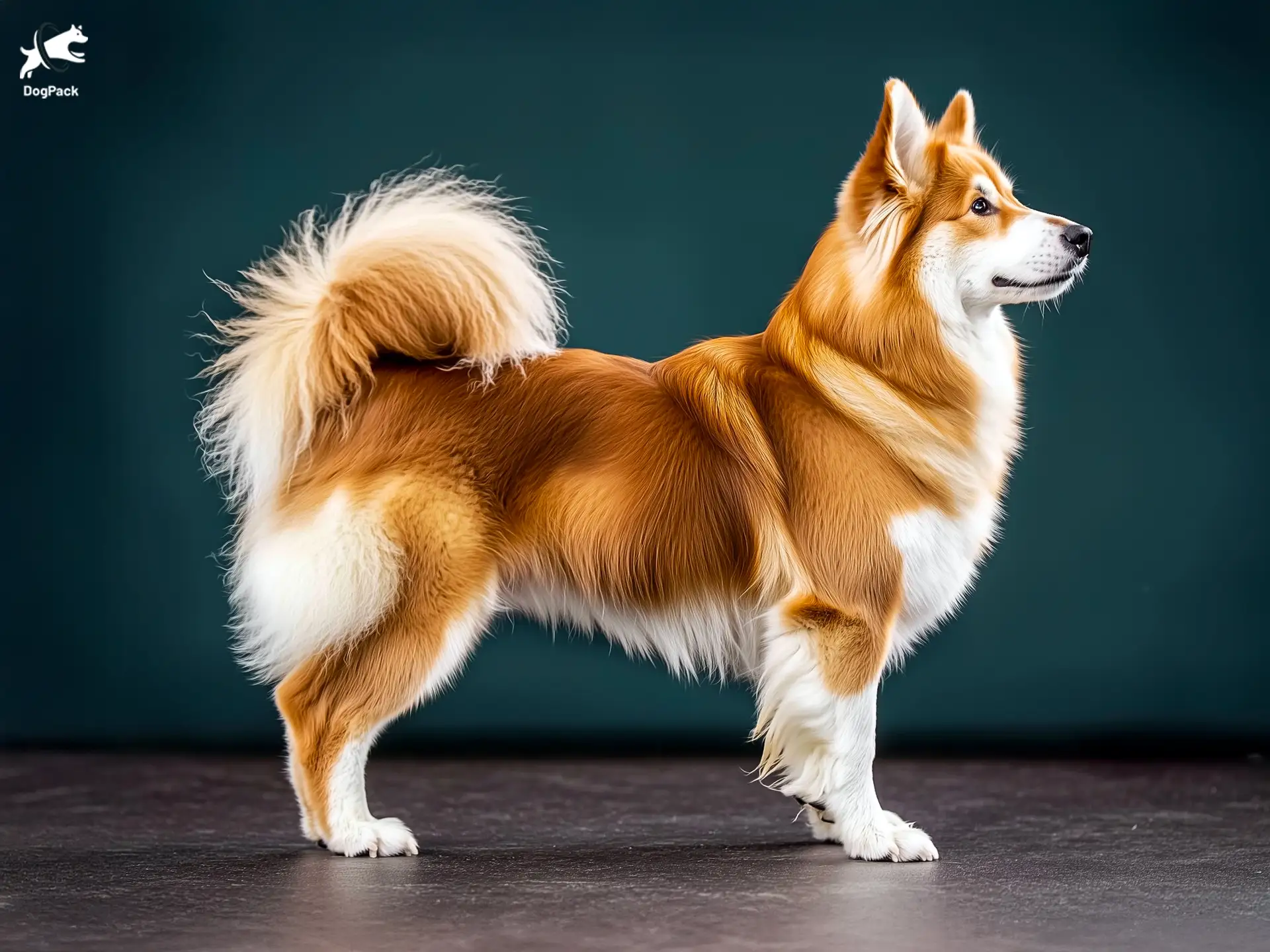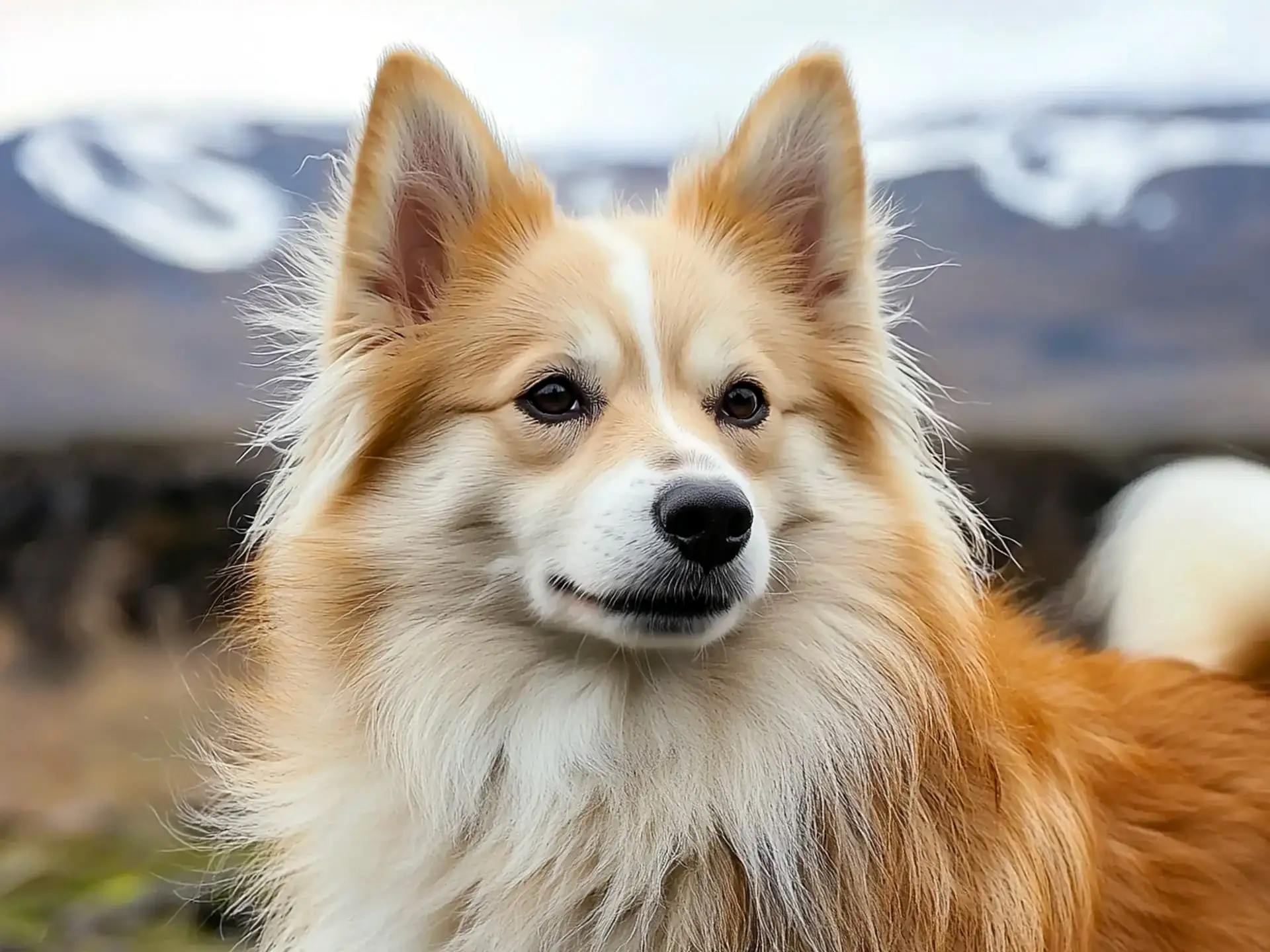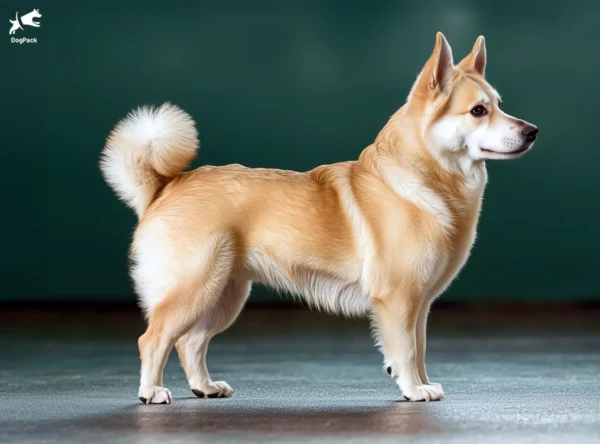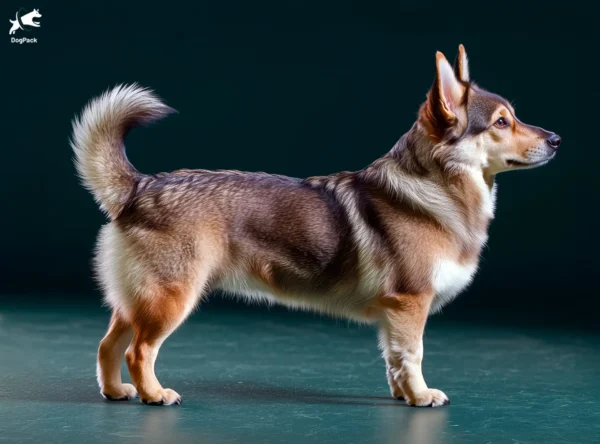Icelandic Sheepdog Dog Breed Info & Overview
The Icelandic Sheepdog, a lively Nordic herder, is known for its friendly demeanor and unwavering devotion. Originally bred to navigate Iceland’s rugged terrain while rounding up sheep, this adaptable breed thrives in active family life. With a fluffy double coat, a distinctive curled tail, and keen intelligence, the Icelandic Sheepdog is both an enthusiastic worker and a loving, sociable companion.
Characteristics
Pictures
Breed History
Legend says these pups arrived with Viking settlers over 1,000 years ago, riding the tumultuous seas to reach the icy shores of Iceland. Many believe they descended from Scandinavian spitz-type dogs, gradually adapting to the harsh environment. Their sharp herding instincts made them essential for farm life, corralling sheep across the rocky terrain.
Through centuries, these agile canines became a fixture of Iceland’s pastoral landscape. Shepherds prized them for their uncanny ability to manage stubborn flocks and sound the alarm when strangers approached. In fact, it wasn’t uncommon to find an entire hillside echoing with spirited barks as these dogs deftly guided livestock, ensuring the survival of rural communities.
The Icelandic Sheepdog faced near extinction in the late 19th century due to disease and strict import laws. Dedicated breeders and enthusiasts launched revival efforts, preserving the breed’s legacy. Their devotion paid off; these pups remain a cultural treasure in Iceland. Today, you’ll spot them competing in herding trials worldwide and bringing a bit of Nordic charm to enthusiastic dog lovers.
Temperament, Personality
Imagine a dog who greets each day with a wagging tail and an upbeat “Can we play now?” expression, and you’ve got the personality of this friendly herder. They thrive on interaction, eagerly following you around the house and chiming in with a well-timed bark if something catches their attention. Socialization from an early age is key to harnessing their natural optimism.
They’re famously great with kids, matching their boundless energy with a gentle touch that’s well-suited to active families. Whether scampering around a backyard or going for a brisk hike, they relish having partners for all adventures. Some owners joke that these dogs are “part-time shadows,” never straying too far from their beloved humans.
When meeting strangers, they can be reserved at first—sometimes greeting new people with a polite bark—yet they quickly warm up if introduced calmly. Their bright, curious eyes keep watch over the home, making them excellent at sounding an alarm. The Icelandic Sheepdog rarely hesitates to express itself vocally, so be prepared for plenty of cheerful conversation.
Physical Characteristics
One of the first things you notice is that trademark bushy tail, curling up over the back like a fluffy question mark. Their spitz-like ears stand erect, always on alert for the faintest sound of excitement—be it a squeaky toy or a doorbell. A compact yet sturdy frame helps them handle Iceland’s rugged terrain.
They usually sport a thick double coat, consisting of a soft underlayer and a weather-resistant outer layer. Colors vary, but many display combinations of white, tan, black, or chocolate, often accented with delightful markings. They have a moderately broad head with a gentle expression, giving them a friendly look that mirrors their sunny disposition.
Despite being a medium-sized dog, they seem larger-than-life due to their upright posture and confident stance. Their average height ranges around 16 to 18 inches, balanced by a sturdy but not bulky build. The Icelandic Sheepdog is nimble, graceful, and built for agility, ready to traverse hilly fields, chase after a ball, or cuddle up right at your feet.
Health Issues
Though generally robust, these dogs can be susceptible to hip dysplasia, a condition affecting the hip joint’s proper formation. Regular check-ups, including X-rays and vet evaluations, can catch early signs. Responsible breeding programs often screen parents to ensure healthier pups, helping reduce the incidence of inherited issues.
Eye conditions such as cataracts or progressive retinal atrophy can occur, though they’re not extremely common. Annual eye exams remain a smart precaution, especially if you notice any vision changes. Being proactive about vet visits and following recommended vaccination schedules helps keep this lively breed in tip-top shape.
A balanced diet and consistent exercise go a long way in preventing weight gain, which can exacerbate joint issues. Some owners add supplements like glucosamine to support joint health, but always consult with a veterinarian first. Overall, the Icelandic Sheepdog benefits from mindful care and early detection to maintain a vibrant, tail-wagging lifestyle.
Grooming Needs
Don’t let that luxurious coat fool you—while it’s undeniably fluffy, the grooming routine isn’t overly complicated. A good weekly brushing typically keeps shedding under control, though seasonal “coat blows” can unleash enough fur to craft a spare dog or two. A slicker brush or pin brush usually does the trick to remove loose hair.
During heavy shedding periods, stepping up the brushing to every other day helps reduce fur tumbleweeds drifting around your living room. Regular grooming also keeps the coat free of tangles, especially around the ears and hindquarters. Many owners find that an undercoat rake works wonders when the fur starts coming out in tufts.
Baths are only necessary when they get especially grimy—though if your Icelandic Sheepdog loves rolling in the mud (or snowdrifts), you might lather up more often. Be sure to trim nails monthly, as overgrown claws can be uncomfortable or lead to posture problems. Finishing up with teeth cleaning ensures a healthier mouth and fresher puppy kisses.
Exercise Requirements
This bright, energetic canine thrives on daily activity. A quick lap around the block won’t cut it; they’re happiest when given a purpose, like learning new tricks or herding games. A rousing game of fetch, followed by a brisk walk or hike, helps burn off that excess energy and keeps them mentally engaged.
Dog sports such as agility, flyball, or even rally obedience let them flex both brain and brawn. Some owners set up backyard obstacle courses—imagine a mini Nordic Olympics. They appreciate variety, so mixing up their play routines is key to preventing boredom (and the mischief that follows when they’re under-stimulated).
Even in colder climates, they’re raring to go, thanks to a coat that shrugs off chilly breezes. However, in hotter weather, scheduling playtime during cooler parts of the day keeps them comfortable. The Icelandic Sheepdog isn’t one to lounge about for hours, so plan on at least one or two sessions of heart-pumping activity daily.
Training Tips
Firm yet gentle training works best with these clever dogs. They respond well to positive reinforcement—treats, praise, and fun games all rank highly in their world. Harsh methods can backfire, dampening their enthusiasm. Consistency is your ally: simple commands repeated calmly help them form good habits and ensure they know what’s expected.
Because they’re naturally alert and vocal, teaching a “quiet” cue early on can save you from endless barking marathons. Short, focused sessions keep their attention, as they may start daydreaming if drilling goes on too long. Many owners report that basic obedience training becomes a bonding experience, building a mutual sense of trust and teamwork.
Socialization from puppyhood pays huge dividends in an Icelandic Sheepdog’s development. Introduce them to a variety of sights, sounds, and people so they’re comfortable in different settings. Their herding instincts might lead them to gently “round up” children or other pets—so it helps to guide this behavior in a positive direction with consistent commands and redirection.
Nutrition, Diet
The Icelandic Sheepdog thrives on a diet that balances protein, fats, and a moderate level of carbohydrates. Because of their active lifestyle and historical roots in herding, they often do well with a slightly higher protein intake—think around 25–30% protein in a premium dog food formulated for medium-sized, high-energy breeds.
Most adult dogs of this breed weigh between 20 and 30 pounds, so starting at roughly 1.5 to 2 cups of quality kibble per day is a good baseline. Some active individuals—especially those engaging in dog sports—may require closer to 2.5 cups. It’s wise to divide meals into two daily feedings to maintain consistent energy and healthy digestion.
Look for formulas with natural protein sources, like fish, chicken, or lamb. Icelandic Sheepdogs do well with the inclusion of omega-3-rich foods (or supplements) to support skin and coat health. Every dog’s metabolism varies, so monitor your pup’s weight and adjust portions accordingly. If in doubt, consult with a veterinarian who understands this breed’s specific nutritional demands.
Adoption, Breeders
If you’re eager to welcome one of these charming Nordic dogs, start by contacting reputable breeders affiliated with recognized clubs. Seek out those who health-test their breeding stock for issues like hip dysplasia and eye problems. Don’t be shy about asking for references from other owners—they’ll offer honest insights into the pup’s lineage and temperament.
Adoption is a fantastic option, too. Although the breed is somewhat rare, rescues occasionally feature Icelandic Sheepdogs in need of a forever home. Scour local shelter listings and breed-specific rescue groups to find a match. Patience may be key, as it could take time to locate this uncommon breed through traditional rescue avenues.
For deeper guidance, check out the Icelandic Sheepdog Association of America or Petfinder for adoption possibilities. Both resources offer detailed breed info and connect you to rescue groups or certified breeders. When you do find the right dog, expect a thorough application process—breeders and rescues alike want to ensure these lively pups land in supportive, committed homes.
Family Pet?
Families with children often adore this breed’s playful spirit and gentle herding instincts. Parents will appreciate their watchful nature—no suspicious squirrel goes unnoticed. While they might “bark first and ask questions later,” early training helps them differentiate genuine threats from everyday excitement, making them trusty watchdogs without being aggressive.
Kids who love active play will find an enthusiastic companion for backyard shenanigans or park trips. However, it’s wise to supervise interactions with very young children until everyone learns proper boundaries. This dog may try a friendly nudge or two as part of its herding heritage, so teaching youngsters to stand firm and calm can minimize confusion.
Existing pets usually mesh well if introductions are gradual. The Icelandic Sheepdog’s sociable demeanor shines when they have playmates—be they feline or canine. They can adapt to various living arrangements, but families who enjoy shared outdoor adventures are the best fit. Expect plenty of fun, fur, and happy chaos in a household that welcomes this Nordic charmer.
Right For You?
If you love the idea of a loyal, energetic companion who thrives on involvement in daily routines, this breed could be your perfect match. They’re an especially strong candidate for folks who can dedicate time to training, exercise, and socialization. Apartment living is possible, but be prepared to manage noise—these pups have a knack for vocalizing enthusiasm.
They flourish in homes with yards or easy access to parks, thanks to a high energy level. If you’re a runner, hiker, or fan of dog sports, the Icelandic Sheepdog becomes an ideal partner, always ready to hit the trail or chase a flying disc. First-time owners might find their readiness to please refreshing, as long as they stay consistent.
All that said, a person looking for a quiet, low-activity companion might want a calmer breed. These dogs are known to be nosey, always wanting to be part of the action. But if you’re game for a cheerful, busy friend who thrives on teamwork, you’ll likely share a delightfully lively life with this eager herder by your side.
Conclusion
Enthusiastic, friendly, and brimming with curiosity, the Icelandic Sheepdog offers a one-of-a-kind blend of herding instinct and devoted companionship. They’re well-suited to active households that can keep up with their energy and enjoy their chatty personality. If you’re seeking a loyal, trainable partner in fun—and don’t mind a bit of extra fur—this Nordic gem could be the perfect canine match.
FAQs
-
Why does the Icelandic Sheepdog have an extra toe?
Some Icelandic Sheepdogs are born with double dewclaws on their hind legs, a trait historically valued for stability on rough terrain. This unique feature helps them navigate rocky landscapes, snow, and uneven ground, making them well-suited for herding in Iceland’s rugged environment.
-
Do Icelandic Sheepdogs have different barks for different situations?
Yes, the Icelandic Sheepdog is highly vocal and known for its distinct bark variations. They may have different sounds for alerting owners to strangers, herding animals, or expressing excitement. This adaptive communication stylemade them indispensable to Icelandic farmers.
-
How well do Icelandic Sheepdogs handle extreme weather?
Bred for Iceland’s harsh climate, the Icelandic Sheepdog thrives in cold weather. Their thick double coat provides insulation against snow and wind. However, in warmer climates, they need plenty of shade, hydration, and regular grooming to prevent overheating.
-
What unusual instincts do Icelandic Sheepdogs have?
Unlike some herding breeds, the Icelandic Sheepdog has a natural “watchdog-herding” instinct—they don’t just move livestock but also alert owners to predators and potential threats. This blend of guardian and herding behavior makes them unique among farm dogs.
-
How rare is the Icelandic Sheepdog outside of Iceland?
The Icelandic Sheepdog is considered a rare breed internationally, with only a few thousand registered worldwide. While more common in Scandinavia and the U.S., dedicated breed clubs work to preserve their lineage and prevent genetic bottlenecks.
Breed Ratings
Quick to learn and eager to please, though they can be independent at times.
These dogs love to romp, chase, and engage in games with family members.
A lively breed that enjoys daily exercise, from walks to more vigorous sports.
The double coat sheds moderately year-round, with heavier seasonal blowouts.
While not extreme, they may chase smaller animals due to natural curiosity.
Weekly brushing is essential to manage shedding, though it’s not overly difficult.
Highly responsive to positive reinforcement, yet they benefit from firm consistency.
They bond strongly and can become anxious if left alone too long.
Known to be vocal, these dogs alert at even minor triggers.
Minimal drool, so no need to keep a towel handy.
They typically get along well with other dogs, especially when socialized early.
Mostly robust but should be monitored for hip and eye issues.














